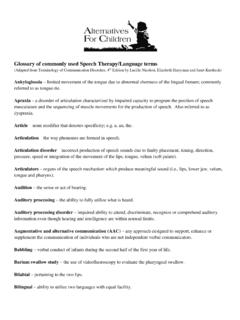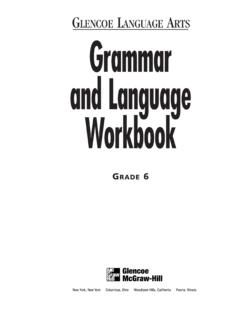Transcription of Stanford typed dependencies manual
1 Stanford typed dependencies manualMarie-Catherine de Marneffe and Christopher D. ManningSeptember 2008 Revised for the Stanford Parser v. in September 2016 Please note that this manual describes the original Stanford dependencies representation. As of ver-sion , the default representation output by the Stanford Parser and Stanford CoreNLP is the newUniversal dependencies (UD) representation, and we no longer maintain the original Stanford Depen-dencies representation. For a description of the UD representation, take a look at the Universal Depen-dencies documentation the discussion of theenhancedandenhanced++UD representations by Schuster and Manning (2016).1 IntroductionThe Stanford typed dependencies representation was designed to provide a simple description of thegrammatical relationships in a sentence that can easily be understood and effectively used by peoplewithout linguistic expertise who want to extract textual relations.
2 In particular, rather than the phrasestructure representations that have long dominated in the computational linguistic community, it repre-sents all sentence relationships uniformly as typed dependency relations. That is, as triples of a relationbetween pairs of words, such as the subject ofdistributesisBell. Our experience is that this simple,uniform representation is quite accessible to non-linguists thinking about tasks involving informationextraction from text and is effective in relation extraction is an example sentence:Bell, based in Los Angeles, makes and distributes electronic, computer and building this sentence, the Stanford dependencies (SD) representation is:nsubj(makes-8, Bell-1)nsubj(distributes-10, Bell-1)vmod(Bell-1, based-3)nn(Angeles-6, Los-5)prepin(based-3, Angeles-6)root(ROOT-0, makes-8)conjand(makes-8, distributes-10)amod(products-16, electronic-11)conjand(electronic-11, computer-13)amod(products-16, computer-13)conjand(electronic-11, building-15)1 Bellbased partmoddistributesnsubjproductsdobjmakes nsubj conj_and dobjAngeles prep_inLos nnelectronic amodbuildingamodcomputeramod conj_andconj_andFigure 1.
3 Graphical representation of the Stanford dependencies for the sentence:Bell, based in LosAngeles, makes and distributes electronic, computer and building (products-16, building-15)dobj(makes-8, products-16)dobj(distributes-10, products-16)These dependencies map straightforwardly onto a directed graph representation, in which words inthe sentence are nodes in the graph and grammatical relations are edge labels. Figure 1 gives the graphrepresentation for the example sentence overview:This manual provides documentation for the set of dependencies defined forEnglish. There is also a Stanford Dependency representation available for Chinese, but it is not furtherdiscussed here. Starting in 2014, there has been work to extend Stanford dependencies to be generallyapplicable cross-linguistically. Initial work appeared in de Marneffe et al. (2014), and the current guide-lines for Universal dependencies (UD) can be found ForSD, Section 2 of the manual defines the grammatical relations and the taxonomic hierarchy over themappears in section 3.
4 This is then followed by a description of the several variant dependency repre-sentations available, aimed at different use cases (section 4), some details of the software available forgenerating Stanford dependencies (section 5), and references to further discussion and use of the SDrepresentation (section 6).2 Definitions of the Stanford typed dependenciesThe current representation contains approximately 50 grammatical relations (depending slightly on theoptions discussed in section 4). The dependencies are all binary relations: a grammatical relation holdsbetween agovernor(also known as aregentor ahead) and adependent. The grammatical relations aredefined below, in alphabetical order according to the dependency s abbreviated name (which appears inthe parser output). The definitions make use of the Penn Treebank part -of- speech tags and phrasal : adjectival complementAn adjectival complement of a verb is an adjectival phrase which functions as the complement (like anobject of the verb).
5 Shelooksverybeautifulnsubjacompadvmodadv cl: adverbial clause modifierAn adverbial clause modifier of a VP or S is a clause modifying the verb (temporal clause, consequence,conditional clause, purpose clause, etc.). The accident happened as the night was falling advcl(happened, falling) If you know who did it, you should tell the teacher advcl(tell, know) He talked to him in order to secure the account advcl(talked, secure)advmod: adverb modifierAn adverb modifier of a word is a (non-clausal) adverb or adverb-headed phrase that serves to modifythe meaning of the word. Genetically modified food advmod(modified, genetically) less often advmod(often, less)agent: agentAn agent is the complement of a passive verb which is introduced by the preposition by and does theaction. This relation only appears in the collapsed dependencies , where it can replaceprepby, whereappropriate. It does not appear in basic dependencies output.
6 The man has been killed by the police agent(killed, police) Effects caused by the protein are important agent(caused, protein)amod: adjectival modifierAn adjectival modifier of an NP is any adjectival phrase that serves to modify the meaning of the NP. Sam eats red meat amod(meat, red) Sam took out a 3 million dollar loan amod(loan, dollar) Sam took out a $ 3 million loan amod(loan, $)appos: appositional modifierAn appositional modifier of an NP is an NP immediately to the right of the first NP that serves to defineor modify that NP. It includes parenthesized examples, as well as defining abbreviations in one of ,mybrother,arrivedapposBill(John scousin)apposTheAustralianBroadcastingCo rporation(ABC)appos3aux: auxiliaryAn auxiliary of a clause is a non-main verb of the clause, , a modal auxiliary, or a form of be , do or have in a periphrastic : passive auxiliaryA passive auxiliary of a clause is a non-main verb of the clause which contains the passive information.
7 Kennedy has been killed auxpass(killed, been)aux(killed,has) Kennedy was/got killed auxpass(killed, was/got)cc: coordinationA coordination is the relation between an element of a conjunct and the coordinating conjunction word ofthe conjunct. (Note: different dependency grammars have different treatments of coordination. We takeone conjunct of a conjunction (normally the first) as the head of the conjunction.) A conjunction mayalso appear at the beginning of a sentence. This is also called a cc, and dependent on the root predicateof the sentence. Bill is big and honest cc(big, and) They either ski or snowboard cc(ski, or) And then we left. cc(left, And)ccomp: clausal complementA clausal complement of a verb or adjective is a dependent clause with an internal subject which func-tions like an object of the verb, or adjective. Clausal complements for nouns are limited to complementclauses with a subset of nouns like fact or report.
8 We analyze them the same (parallel to the analysisof this class as content clauses in Huddleston and Pullum 2002). Such clausal complements are usuallyfinite (though there are occasional remnant English subjunctives). He says that you like to swim ccomp(says, like) I am certain that he did it ccomp(certain, did) I admire the fact that you are honest ccomp(fact, honest)conj: conjunctA conjunct is the relation between two elements connected by a coordinating conjunction, such as and , or , etc. We treat conjunctions asymmetrically: The head of the relation is the first conjunct and otherconjunctions depend on it via theconjrelation. Bill is big and honest conj(big, honest) They either ski or snowboard conj(ski, snowboard)cop: copulaA copula is the relation between the complement of a copular verb and the copular verb. (We normallytake a copula as a dependent of its complement; see the discussion in section 4.)
9 4 Bill is big cop(big, is) Bill is an honest man cop(man, is)csubj: clausal subjectA clausal subject is a clausal syntactic subject of a clause, , the subject is itself a clause. The governorof this relation might not always be a verb: when the verb is a copular verb, the root of the clause is thecomplement of the copular verb. In the two following examples, what she said is the subject. What she said makes sense csubj(makes, said) What she said is not true csubj(true, said)csubjpass: clausal passive subjectA clausal passive subject is a clausal syntactic subject of a passive clause. In the example below, thatshe lied is the subject. That she lied was suspected by everyone csubjpass(suspected, lied)dep: dependentA dependency is labeled asdepwhen the system is unable to determine a more precise dependencyrelation between two words. This may be because of a weird grammatical construction, a limitation inthe Stanford Dependency conversion software, a parser error, or because of an unresolved long distancedependency.
10 Then, as if to show that he could, .. dep(show, if)det: determinerA determiner is the relation between the head of an NP and its determiner. The man is here det(man, the) Which book do you prefer? det(book, which)discourse: discourse elementThis is used for interjections and other discourse particles and elements (which are not clearly linked tothe structure of the sentence, except in an expressive way). We generally follow the guidelines of whatthe Penn Treebanks count as an INTJ. They define this to include: interjections (oh,uh-huh,Welcome),fillers (um,ah), and discourse markers (well,like,actually, but notyou know).IguazuisinArgentina:)discoursedobj : direct objectThe direct object of a VP is the noun phrase which is the (accusative) object of the verb. She gave me a raise dobj(gave, raise) They win the lottery dobj(win, lottery)5expl: expletiveThis relation captures an existential there.





